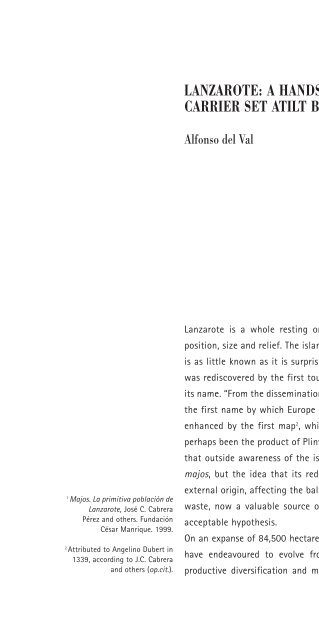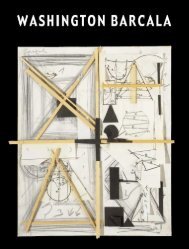Lanzarote: el papel de la crisis - Fundación César Manrique
Lanzarote: el papel de la crisis - Fundación César Manrique
Lanzarote: el papel de la crisis - Fundación César Manrique
Create successful ePaper yourself
Turn your PDF publications into a flip-book with our unique Google optimized e-Paper software.
1 Majos. La primitiva pob<strong>la</strong>ción <strong>de</strong><br />
<strong>Lanzarote</strong>, José C. Cabrera<br />
Pérez and others. <strong>Fundación</strong><br />
<strong>César</strong> <strong>Manrique</strong>. 1999.<br />
2 Attributed to Ang<strong>el</strong>ino Dubert in<br />
1339, according to J.C. Cabrera<br />
and others (op.cit.).<br />
LANZAROTE: A HANDSOME AIRCRAFT<br />
CARRIER SET ATILT BY ITS CONTAMINATING CARGO<br />
Alfonso d<strong>el</strong> Val<br />
<strong>Lanzarote</strong> is a whole resting on the At<strong>la</strong>ntic, easy to seize because of its accessible<br />
position, size and r<strong>el</strong>ief. The is<strong>la</strong>nd’s evolution from what, for us, is antiquity, prehistory...,<br />
is as little known as it is surprising. As far back as the early fourteenth century, when it<br />
was rediscovered by the first tourist-adventurer, the Genoese Lanc<strong>el</strong>ott Maloc<strong>el</strong>lo, it lost<br />
its name. “From the dissemination of the portu<strong>la</strong>n chart, such would be the first image and<br />
the first name by which Europe would know this is<strong>la</strong>nd” 1 . This image, however, would be<br />
enhanced by the first map2 , which was certainly more accurate than the ones that had<br />
perhaps been the product of Pliny’s and Ptolemy’s dreams. We know little of the effects of<br />
that outsi<strong>de</strong> awareness of the is<strong>la</strong>nd on the scant popu<strong>la</strong>tion of 1,000 or possibly 3,000<br />
majos, but the i<strong>de</strong>a that its rediscovery in the Middle Ages led to the first <strong>crisis</strong> of an<br />
external origin, affecting the ba<strong>la</strong>nce between resources and popu<strong>la</strong>tion and, accordingly,<br />
waste, now a valuable source of archaeological and anthropological information, is an<br />
acceptable hypothesis.<br />
On an expanse of 84,500 hectares, the various popu<strong>la</strong>tions of the ínsu<strong>la</strong> <strong>de</strong> Lanc<strong>el</strong>ott must<br />
have en<strong>de</strong>avoured to evolve from the ever more difficult ba<strong>la</strong>nce between maximum<br />
productive diversification and minimum vulnerability on the one hand and between the<br />
233
















![Becas y premios de la Fundación César Manrique [1997-2006]](https://img.yumpu.com/20766851/1/184x260/becas-y-premios-de-la-fundacion-cesar-manrique-1997-2006.jpg?quality=85)
